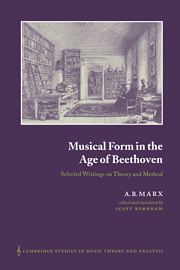Book contents
- Frontmatter
- Contents
- Foreword
- Preface
- Introduction: Music and Spirit
- PART I MUSIC THEORY AS EDUCATION OF THE SPIRIT
- 1 The Old School of Music in Conflict with our Times: selected excerpts
- 2 A Practical and Theoretical Method of Musical Composition, vol. I: selected excerpts
- PART II MARX'S FORMENLEHRE IN THEORY AND APPLICATION
- Part III HERMENEUTIC ANALYSIS AND THE IDEE
- Select bibliography
- Index
2 - A Practical and Theoretical Method of Musical Composition, vol. I: selected excerpts
Published online by Cambridge University Press: 03 December 2009
- Frontmatter
- Contents
- Foreword
- Preface
- Introduction: Music and Spirit
- PART I MUSIC THEORY AS EDUCATION OF THE SPIRIT
- 1 The Old School of Music in Conflict with our Times: selected excerpts
- 2 A Practical and Theoretical Method of Musical Composition, vol. I: selected excerpts
- PART II MARX'S FORMENLEHRE IN THEORY AND APPLICATION
- Part III HERMENEUTIC ANALYSIS AND THE IDEE
- Select bibliography
- Index
Summary
Marx wrote his famous treatise on composition as a result of his experiences teaching composition at the University of Berlin. The first two volumes were published in 1837 and 1838; they were already in their second editions when he published the next two volumes in 1845 and 1847.
After the foregoing excerpts on the nature and goals of Marx's progressive theory of music pedagogy, the purpose of the following excerpts is to demonstrate its initial application within his compositional method. I have omitted and paraphrased some of the more abstract notions of form that appear in these pages, since Marx handles them explicitly in the essay entitled “Form in music,” which can be found in Part II of this volume.
INTRODUCTION
SECTION ONE: CHIEF MANDATE OF THE COMPOSITIONAL METHOD
{1} The compositional method has first and foremost the purely practical goal of providing direction for musical composition, of enhancing ones compositional skill – presuming aptitude and practice on the part of the student. It entirely fulfills this mandate only when it teaches everything, when it enhances all the skills that a composer true to the calling is obliged to attain; it comprehends nothing less than the whole of musical art.
To this end it must first present an array of positive information (e.g. on the technical usefulness of instruments). At the same time, it may presume a certain degree of general education, certain supplemental information and skills, and an elementary knowledge of musical rudiments – or else it may indicate the means to attain such knowledge.
- Type
- Chapter
- Information
- Musical Form in the Age of BeethovenSelected Writings on Theory and Method, pp. 35 - 52Publisher: Cambridge University PressPrint publication year: 1997



